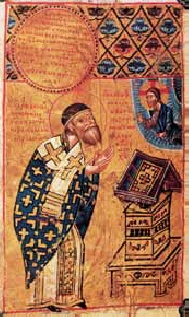Jakov of Serres

Jakov of Serres (Serbian: Јаков Серски; 1300–1365) was a medieval Serbian writer, scholar, translator, and hierarch of the Serbian Orthodox Church, one of the most important men of letters working in the 14th century.[1][2]
Biography
Evidence about his life is scarce, but his literary legacy suggests an excellent knowledge of Greek and Slavic languages. In 1343, King (and eventually Emperor)
After the sudden death of Stefan Dušan in 1355, Jelena, Dušan's wife, became a nun, took the name Jelisaveta, and moved from Skoplje, the capital of Serbia, to Serres. From there, she administered her estates; and Jakov was at her side as wise counsel. Jakov wrote the
He is illustrated in the Serbian manuscript of scribe
See also
- Teodosije the Hilandarian (1246–1328), one of the most important Serbian writers in the Middle Ages
- Saint Archangels Monastery
- Agiou Pavlou monastery
- Lazar the Hilandarian(fl. 1404), the first known Serbian and Russian watchmaker
- Pachomius the Serb (fl. 1440s – 1484), hagiographer of the Russian Church
- Miroslav Gospel
- Gabriel the Hilandarian
References
- ^ John Van Antwerp Fine -The late medieval Balkans: a critical survey from the late twelfth... 1987 – Page 439 "The likelihood of this identification is enhanced by the fact that Jacob of Serres sent several books to the Monastery of Mount Sinai in 1360. Ties between Serbia and Sinai had long existed. Milutin had financed the building on Sinai of a church ..."
- ^ "The British Library Catalogue of Illuminated Manuscripts". British Library.
- ^ Orientalia Christiana periodica. Pont. institutum orientalium studiorum. 1980.
An illumination in a 14th century Serbian MS, the Slavonic Tetraevange- lion of codex British Museum Add. 39626 (A. D. 1354), portrays Metropolitan Jacob of Serres fully vested and coifed with a black cap (f. 292V) (78).
- ISBN 978-1-899828-36-4.
makes possible an accurate dating (1354). 4 The epigraphs accompanying Jakov's portrait (f. 292v) render easier the interpretation of the iconography of the miniature5 (Fig. 1). Moreover Jakov of Serres is a comparatively well known ...
- polystaurionand omophorion and wearing a dark, hemispherical hat, which may ...

